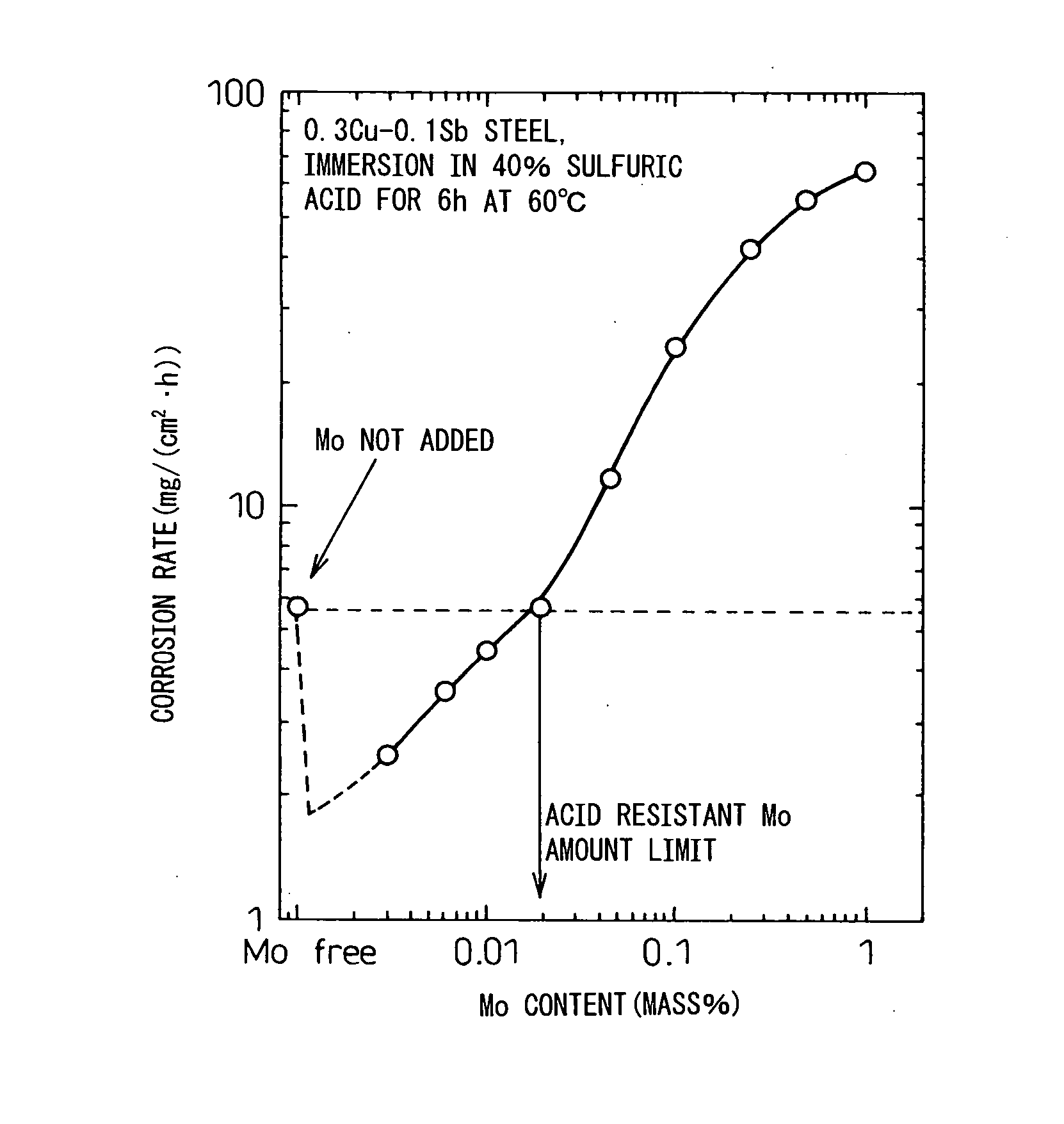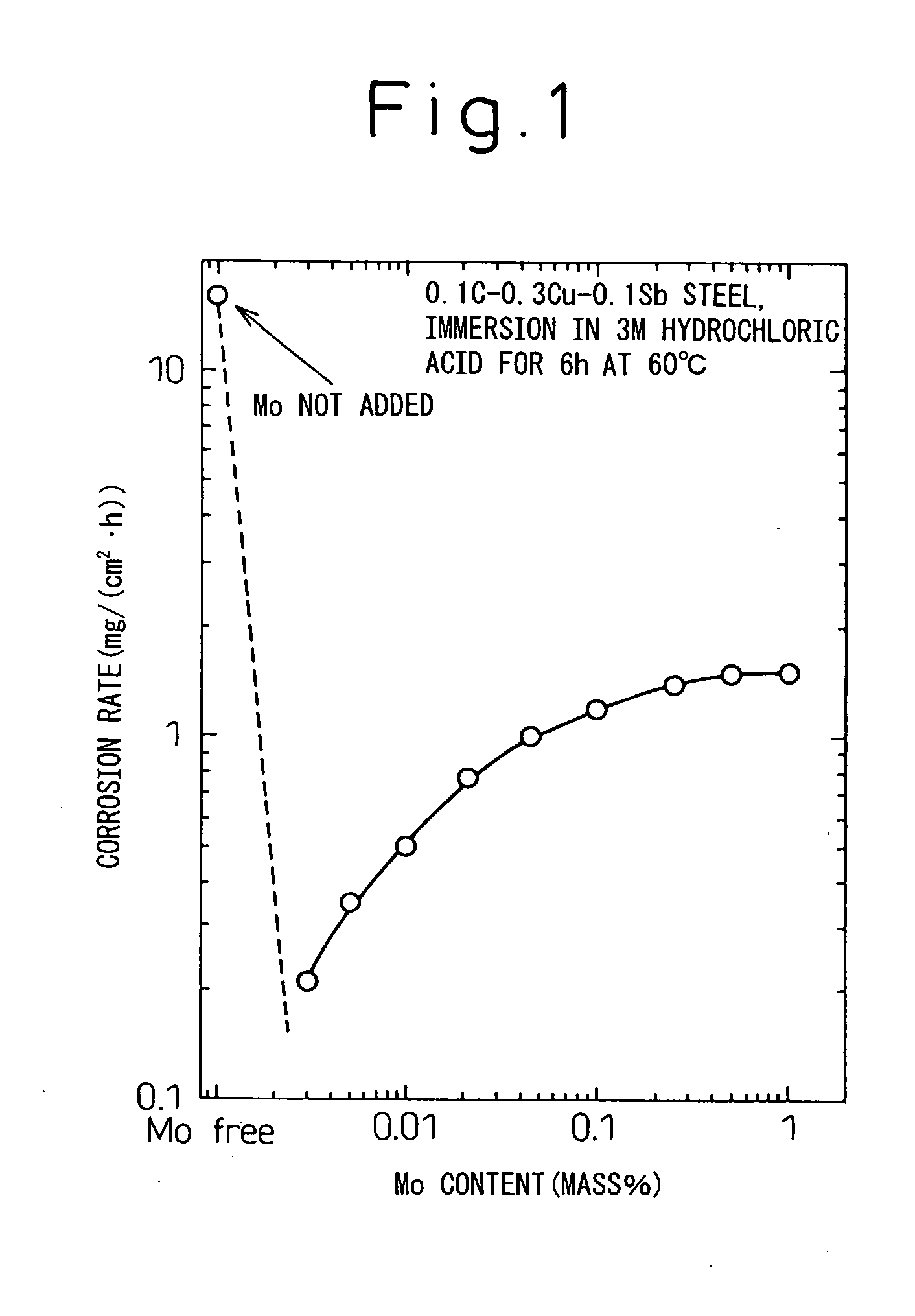Low alloy steel excellent in resistance to corrosion by hydrochloric acid and corrosion by sulfuric acid and weld joint comprising the same
a low alloy steel and hydrochloric acid technology, applied in the direction of furnaces, heat treatment equipment, soldering equipment, etc., can solve the problems of deteriorating hydrochloric acid resistance to worse than that of steel, causing sulfuric acid dew-point corrosion, etc., to achieve excellent corrosion resistance, excellent economic efficiency, excellent resistance to sulfuric acid
- Summary
- Abstract
- Description
- Claims
- Application Information
AI Technical Summary
Benefits of technology
Problems solved by technology
Method used
Image
Examples
example
Example 1
Steels containing chemical components shown in Tables 1, 2 (sequel 1 of Table 1), 3 (sequel 2 of Table 1) and 4 (sequel 3 of Table 1) were melted and refined in a 50 kg vacuum melting furnace, the steel ingots were processed into slabs, and the slabs were reheated and thereafter hot rolled into hot-rolled steel sheets 6 mm in thickness in the finishing temperature range from 800° C. to 900° C. and then cooled in the air. Test pieces for corrosion tests and tensile tests were sampled from the hot-rolled steel sheets. Further, some hot-rolled steel sheets were pickled, cold rolled into cold-rolled steel sheets 1.2 mm in thickness, and thereafter annealed in a salt bath for 60 sec. at a temperature of 700° C. Then, test pieces for tensile tests were sampled from the cold-rolled steel sheets.
TABLE 1Chemical components of specimen(Mass %)CSiMnPSCuCrNiMoSbAlNNbVTiOthersAlElCom-A10.1600.030.230.0210.0150.02—0.00—0.0010.0250.0045———— 5.5parativeA20.0900.350.420.0190.0140.34—0.1...
example 2
Table 9 shows the chemical components of the core wires for tests and Tables 10 and 11 (sequel of Table 10) show the chemical compositions of the coated arc welding rod (rod diameter: 4.0 mm) produced according to the present invention and used for the tests.
TABLE 9Components of core wire specimen(Mass %)CodeCSiMnPSCuNiSbMoCrA0.0100.010.480.0070.0050.010.005<0.0020.0030.001B0.0700.010.520.0130.0110.010.007<0.0020.0010.002C0.0800.020.270.0350.0100.020.004<0.0020.0030.001D0.0500.010.250.0300.0170.020.003<0.0020.0040.003E0.0500.010.300.0180.0400.020.008<0.0020.0010.002F0.040.020.320.0150.0350.010.006<0.0020.0020.003
TABLE 10Configuration of welding rod specimenCoreWeldingwireCoating composition (mass %)Classificationrod codecodeCaCO3CaF2Fe—SiMnCuNiSbFe—MoCrTiO2BaCO3SiC*OthersComparativeW1B46.124.212.54.20000.0204.55.503.0specimenW2A53.218.813.50.60.900004.43.904.7W3B49.626.312.00.71.10001.83.5005.0W4C47.623.512.94.11.20.50.3001.54.304.1W5E50.322.511.93.7...
PUM
| Property | Measurement | Unit |
|---|---|---|
| mass % | aaaaa | aaaaa |
| mass % | aaaaa | aaaaa |
| temperature | aaaaa | aaaaa |
Abstract
Description
Claims
Application Information
 Login to View More
Login to View More - R&D
- Intellectual Property
- Life Sciences
- Materials
- Tech Scout
- Unparalleled Data Quality
- Higher Quality Content
- 60% Fewer Hallucinations
Browse by: Latest US Patents, China's latest patents, Technical Efficacy Thesaurus, Application Domain, Technology Topic, Popular Technical Reports.
© 2025 PatSnap. All rights reserved.Legal|Privacy policy|Modern Slavery Act Transparency Statement|Sitemap|About US| Contact US: help@patsnap.com



